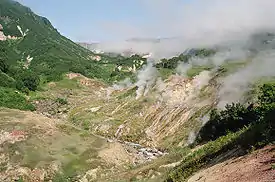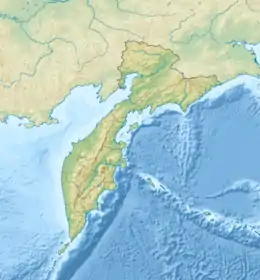Valley of Geysers
The Valley of Geysers (Russian: Долина гейзеров) is a geyser field on Kamchatka Peninsula, Russia, and has the second largest concentration of geysers in the world. This six-kilometre-long (3.7 mi) basin with approximately ninety geysers and many hot springs is situated on the Kamchatka Peninsula in the Russian Far East, predominantly on the left bank of the ever-deepening Geysernaya River, into which geothermal waters flow from a relatively young stratovolcano, Kikhpinych. Temperatures have been found to be 250 °C (482 °F), 500 m (1,640 ft) below the caldera ground.[1] It is part of the Kronotsky Nature Reserve, which, in turn, is incorporated into the World Heritage Site "Volcanoes of Kamchatka". The valley is difficult to reach, with helicopters providing the only feasible means of transport.
| Valley of Geysers | |
|---|---|
 The Valley of Geysers as of September 2006, before the mudflow | |
 Location in Kamchatka Krai, Russia | |
| Location | Kamchatka Peninsula, Russia |
| Coordinates | 54.431°N 160.139°E |
History

The "pulsating" geysers of Kamchatka were discovered by a local scientist, Tatyana Ustinova, in 1941.[2] She published her findings fourteen years later, but there was little exploration of the area until 1972. A systematic survey was undertaken in the mid-1970s, and an automatic monitoring system was introduced in 1990. Over thirty geysers were given names; among these was the Giant geyser (Velikan), capable of producing a jet of water reaching up to 40 meters (131 ft). From the 1980s, the area was promoted across the USSR as one of the tourist magnets of Kamchatka and the Russian Far East. Foreign tourists were allowed into the valley in 1991. About 3,000 tourists visited the site annually.[3]
2007 Mudflow damage and aftermath
On June 3, 2007, a massive mudflow inundated two thirds of the valley.[4] Oleg Mitvol of Russia's Service for the Oversight of Natural Resources said "we witnessed a unique natural event, but the consequences of such a natural catastrophe are irreversible."[5] The World Heritage Site also expressed its deep concern over the issue.[6] "This is tragic for humankind, in that we have lost one of the great natural wonders of the world", the World Wildlife Fund spokesman commented.[5] On June 5, it was reported that a thermal lake was forming above the valley.[7] The landslide occurred while the documentary Wild Russia was filmed; it features footage of before and after the disaster.
The extent of permanent change is not yet clear, but may be less than was originally thought. As of June 9, 2007, waters have receded somewhat, exposing some of the submerged features. Velikan (Giant) Geyser, one of the field's largest, was not buried in the slide and has recently been observed to be active.[8]
See also
| Wikimedia Commons has media related to Valley of Geysers. |
References
- Waltham, T (2001). "A guide to the volcanoes of the southern Kamchatka, Russia" (PDF). Proceedings of the Geologists' Association. 112: 67–78. doi:10.1016/s0016-7878(01)80051-1.
- "Natural Wonder of the World Transformed within Hours, says World Wildlife Fund". earthtimes.com. 2007-06-04. Archived from the original on 2012-07-30. Retrieved 2007-06-05.
- "Mudslide fully changes terrain in Kamchatka's Valley of Geysers". ITAR-TASS. 2007-06-03. Retrieved 2007-06-05.
- Mehta, Aalok (2007-06-05). "Photo in the News: Russia's Valley of the Geysers Lost in Landslide". National Geographic. Retrieved 2007-06-07.
- Heintz, Jim (2007-06-05). "Massive landslide destroys natural wonder of Russia's Valley of Geysers". Independent. Archived from the original on 2007-06-07. Retrieved 2007-06-05.
- Official site of the World Heritage Centre
- Harding, Luke (2007-06-05). "Mudslide fully changes terrain in Kamchatka's Valley of Geysers". Guardian Unlimited. Retrieved 2007-06-05.
- Shpilenok, Igor (2007-06-09). "June 2007 Special release – The Natural Disaster at the Valley of the Geysers". Archived from the original on 2007-05-13. Retrieved 2007-06-09.
Further reading
- Устинова, Т. И. (1955). Камчатские гейзеры / Geysers of Kamchatka (in Russian). Moscow: State Publisher of Geography Literature. pp. 119 pp. (Google translation)
- Diana Gealdhill, 'Kamchatka', Odyssey Books, 2007.
External links
- Landslide buries Valley of the Geysers at NASA Earth Observatory
- Google Earth model of the Valley of Geysers – photos, movies, maps, schemes, landslide animation
- "Valley Of Geysers, Kamchatka". valleyofgeysers.com.
Russian
Russian and English
- Valley of Geysers – what actually happened, Leonov and Leonov, Institute of Volcanology and Seismology, Far Eastern Branch of the Russian Academy of Sciences, 10 June 2007

